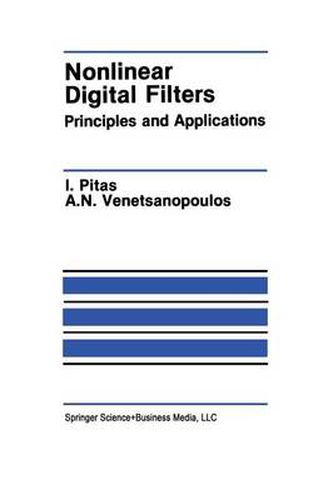Readings Newsletter
Become a Readings Member to make your shopping experience even easier.
Sign in or sign up for free!
You’re not far away from qualifying for FREE standard shipping within Australia
You’ve qualified for FREE standard shipping within Australia
The cart is loading…






This title is printed to order. This book may have been self-published. If so, we cannot guarantee the quality of the content. In the main most books will have gone through the editing process however some may not. We therefore suggest that you be aware of this before ordering this book. If in doubt check either the author or publisher’s details as we are unable to accept any returns unless they are faulty. Please contact us if you have any questions.
The function of a filter is to transform a signal into another one more suit able for a given purpose. As such, filters find applications in telecommunica tions, radar, sonar, remote sensing, geophysical signal processing, image pro cessing, and computer vision. Numerous authors have considered deterministic and statistical approaches for the study of passive, active, digital, multidimen sional, and adaptive filters. Most of the filters considered were linear although the theory of nonlinear filters is developing rapidly, as it is evident by the numerous research papers and a few specialized monographs now available. Our research interests in this area created opportunity for cooperation and co authored publications during the past few years in many nonlinear filter families described in this book. As a result of this cooperation and a visit from John Pitas on a research leave at the University of Toronto in September 1988, the idea for this book was first conceived. The difficulty in writing such a mono graph was that the area seemed fragmented and no general theory was available to encompass the many different kinds of filters presented in the literature. However, the similarities of some families of nonlinear filters and the need for such a monograph providing a broad overview of the whole area made the pro ject worthwhile. The result is the book now in your hands, typeset at the Department of Electrical Engineering of the University of Toronto during the summer of 1989.
$9.00 standard shipping within Australia
FREE standard shipping within Australia for orders over $100.00
Express & International shipping calculated at checkout
This title is printed to order. This book may have been self-published. If so, we cannot guarantee the quality of the content. In the main most books will have gone through the editing process however some may not. We therefore suggest that you be aware of this before ordering this book. If in doubt check either the author or publisher’s details as we are unable to accept any returns unless they are faulty. Please contact us if you have any questions.
The function of a filter is to transform a signal into another one more suit able for a given purpose. As such, filters find applications in telecommunica tions, radar, sonar, remote sensing, geophysical signal processing, image pro cessing, and computer vision. Numerous authors have considered deterministic and statistical approaches for the study of passive, active, digital, multidimen sional, and adaptive filters. Most of the filters considered were linear although the theory of nonlinear filters is developing rapidly, as it is evident by the numerous research papers and a few specialized monographs now available. Our research interests in this area created opportunity for cooperation and co authored publications during the past few years in many nonlinear filter families described in this book. As a result of this cooperation and a visit from John Pitas on a research leave at the University of Toronto in September 1988, the idea for this book was first conceived. The difficulty in writing such a mono graph was that the area seemed fragmented and no general theory was available to encompass the many different kinds of filters presented in the literature. However, the similarities of some families of nonlinear filters and the need for such a monograph providing a broad overview of the whole area made the pro ject worthwhile. The result is the book now in your hands, typeset at the Department of Electrical Engineering of the University of Toronto during the summer of 1989.